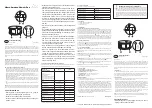
www.fmiproducts.com
125271-01A
3
Millivolt Valves
The remote receiver is connected to the millivolt
valve using the TH (thermostat) terminals on the
terminal block on the gas valve. Connect wires from
the remote receiver to the gas valve.
Operation of the remote receiver is similar to that
of a thermostat in that both turn the gas valve on
and off based on input signals. A thermostat's input
signals are different temperatures. The remote re-
ceiver's input signal comes from the transmitter.
Connect each of the two wires leading from the
TH terminals on the millivolt gas valve to either
of the two wire terminals on the remote receiver.
Normally it does not matter which wire goes to
which terminal.
Electronic Spark Ignitions
The remote control receiver can be connected, in
series, to a 24VAC transformer to the TR (trans-
former) terminal on the electronic module. Connect
the hot wire from the 24VAC transformer to either
of the wire terminals on the remote receiver. Con-
nect another wire (not included) between the other
receiver wire terminal and the TH (thermostat)
terminal on the electronic module.
TERMINAL BLOCK
ON MILLIVOLT
GAS VALVES
TH
TP
TP
TH
THERMOPILE/
PILOT LIGHT
REMOTE
RECEIVER
Figure 6: Millivolt Wiring Diagram
ELECTRONIC MODULE
TR
TH
REMOTE
RECEIVER
neutral wire
24VAC
hot wire
120VAC
110/24VAC
Transformer
OPERATION
MILLIVOLT VALVES
Light your gas appliance following the lighting in-
VWUXFWLRQVWKDWFDPHZLWK\RXUDSSOLDQFH&RQ¿UP
WKDWWKHSLORWÀDPHLVRQLWPXVWEHLQRSHUDWLRQIRU
the main gas valve to operate.
Slide the 3-position button on the remote
receiver to the ON position. The main gas
ÀDPHVKRXOGLJQLWH
Figure 7: Electronic Wiring Diagram
6OLGH WKH EXWWRQ WR 2)) 7KH ÀDPH VKRXOG
H[WLQJXLVKWKHSLORWÀDPHZLOOUHPDLQRQ
Slide the button to REMOTE (the center posi-
tion), then press the ON button on the remote
control to change the system to ON. The main
JDVÀDPHVKRXOGLJQLWH
Electronic Spark Ignitions
Slide the 3-postion button on the remote re-
ceiver to the ON position. The spark electrode
should begin sparking to ignite the pilot (the
pilot may ignite after only one spark). After the
SLORW ÀDPH LV OLW WKH PDLQ JDV YDOYH VKRXOG
RSHQDQGWKHPDLQJDVÀDPHVKRXOGLJQLWH
6OLGHWKHEXWWRQWR2))7KHPDLQJDVÀDPH
DQGSLORWÀDPHVKRXOGERWKH[WLQJXLVK
Slide the button to REMOTE (the center posi-
tion), then press the ON button on the remote
control to change the system to ON. The spark
electrode should begin to ignite the pilot. After
the pilot is lit, the main gas valve should be
RSHQDQGWKHPDLQJDVÀDPHVKRXOGLJQLWH
MATCHING SECURITY CODES
Each remote control can use one of 65,536 unique
security codes. It may be necessary to program
the remote receiver to "LEARN" the security code
of the remote control upon initial use, if batteries
are replaced or if a replacement remote control
is purchased from your dealer. When matching
security codes, be sure the slide button on the
UHFHLYHU LV LQ WKH 5(027( SRVLWLRQ WKH FRGH
will not "LEARN". If the slide switch is in the ON
or OFF position. Program the remote receiver
to "LEARN" a new security code by pushing the
LEARN button on the top of the remote receiver
and then pressing the MODE button on the remote
control. A change in the beeping pattern, at the
receiver, indicates the remote control's code has
been programed into the receiver. When an exist-
ing receiver is matched to a new remote control,
the new security code will override the old one.
The microprocessor that controls the security
code matching procedure is controlled by a tim-
ing function. If you are unsuccessful in matching
WKH VHFXULW\ FRGH RQ WKH ¿UVW DWWHPSW ZDLW
minutes before trying again. This delay allows the
microprocessor to reset its timer circuitry and try
up to two or three more times.






















